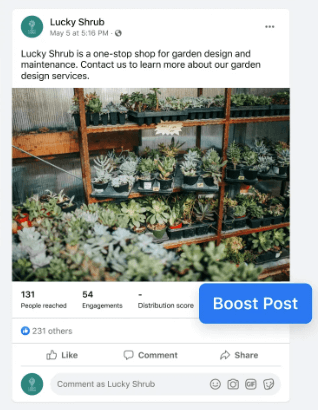In today’s digital-first world, marketing across social channels can be a game-changer for small to medium-sized businesses looking to reach new audiences. Now, some may claim that “no one is on Facebook anymore,” but the Facebook User Statistics tell a different story:
- 253.56 Million Users in the United States
- 53% of buyers research brands and products on the platform
- 18% of American adults made a purchase via Facebook
If your business doesn’t have a Facebook Page, you’re missing out on a valuable opportunity to build brand awareness, engage with customers, and drive sales.
Why Set Up a Facebook Page for Your Business?
A Facebook Business Page isn’t just a social media presence—it’s an extension of your brand that builds credibility, improves search visibility, and fosters community.
Brand Awareness
Facebook remains one of the most cost-effective ways to increase brand visibility, with 67% of users actively searching businesses on the platform before purchasing. With organic reach plus paid options, businesses can effectively get in front of their target audience.
SEO & Google Visibility

While Facebook doesn’t directly impact Google rankings, an optimized Facebook Page can help your business appear in search results.
- Facebook posts often rank on Google for brand-related queries.
- Link-building opportunities arise when your content is shared across platforms.
Customer Engagement & Trust
Facebook enables businesses to build a loyal community of followers, with 90% of users buying from brands they follow. Moreover, customers increasingly expect brands to be active, responsive, and engaging on social media. By interacting with comments, messages, and reviews, businesses can build trust and long-term brand loyalty.
Timely Information & Promotions
Whether you run a brick-and-mortar store or an online business, Facebook is a powerful tool for informing customers. Physical businesses can easily update followers about changes in store hours, closures, or special promotions. Additionally, online and service-based businesses can use the platform to promote exclusive discounts, flash sales, events, and more.
Traffic & Conversions
Facebook Pages help businesses drive website traffic and boost conversions by fostering trust and engagement. Meaningful interactions with customers increase the likelihood of purchases, while boosted posts and Facebook Ads allow businesses to target the right audience and drive sales.
How to Set Up a Facebook Page for Your Business (Step-by-Step Guide)
Step 1: Visit Facebook Business and select “Business or Brand.”
Step 2: Enter Business Details
- Business name (should match your official branding)
- Choose a category (e.g., “Restaurant,” “Consulting,” “Retail”)
- Write a compelling business description (include relevant keywords)
Step 3: Upload Profile & Cover Photos
- Profile Picture: Use your business logo (optimal size: 180x180px)
- Cover Photo: Showcase your brand visually (optimal size: 820x312px)
Step 4: Complete Business Information
- Website URL
- Contact details (email, phone, address)
- Operating hours
- Custom URL (@YourBusinessName)
Step 5: Set Up Call-to-Action (CTA) Button
Choose a CTA button to drive engagement:
- Shop Now
- Contact Us
- Book Appointment
- Learn More
Step 6: Customize Page Settings
- Enable Facebook Messenger for quick communication
- Adjust notifications to stay responsive
- Allow customer reviews and recommendations
Step 7: Start Posting & Engaging (Step-by-Step Guide)
Understanding the Facebook Algorithm

Facebook prioritizes engagement, consistency, and diversity of content. Here’s how to work with the algorithm:
- Post consistently: At least 3-5 times per week to maintain visibility.
- Encourage interactions: More comments, likes, and shares mean better reach.
- Use diverse content formats: Facebook favors videos, carousels, Reels, static images, stories & questions.
- Respond to engagement: Replying to comments boosts post ranking in feeds.
Leveraging Your Audience for Maximum Impact
- Identify Your Target Audience
- Analyze your current customers and their interests.
- Research competitors in your industry.
- Use Facebook Audience Insights to refine your targeting strategy.
- Community Management
- Inbound Engagement
- Respond to comments, questions, and reviews.
- Encourage user-generated content (UGC).
- Use Facebook Messenger for quick responses.
- Outbound Engagement
- Comment on industry-related posts and local business updates.
- Join and engage in Facebook Groups.
- Encourage check-ins, tags, and shares.
- Inbound Engagement
Facebook Post Types

- Single Image – Simple and eye-catching visuals
- Video – High engagement and shareability
- Carousel – Showcase multiple products/services
- Link Posts – Drive traffic to your website
- Text-Only Posts – Conversation starters
- Polls & Interactive Posts – Boost engagement
Writing Captions
A well-crafted caption can increase engagement, drive conversions, and strengthen brand identity. Knowing when to use short vs. long captions is essential.
When to Use Short Captions
Short captions work best for quick, action-driven messages that require little explanation.
- Best for CTA-driven posts – Short captions create urgency and drive immediate action (e.g., “Sale ends tonight! Grab yours now!”).
- Perfect for image-focused content – Let the visual speak for itself while keeping the text concise (e.g., “Weekend vibes. What’s your plan?”).
- Increases scannability – Short captions are easier to read and process in a fast-moving feed.
When to Use Long Captions
Longer captions allow brands to tell a story, provide context, and build a stronger emotional connection with their audience.
- Storytelling – Share behind-the-scenes content or customer success stories.
- Educational content – Explain product benefits and industry trends or offer insights.
- Engagement through conversation – Encouraging users to comment or share their thoughts increases interaction.
Hooks & Calls to Action (CTAs)
A hook is the first line of your caption—its job is to grab attention. A CTA (call to action) guides the user on what to do next.

Hook Examples:
- “3 mistakes you’re making when…” (List-based)
- “We asked 100 customers, and here’s what they said…” (Data-driven)
Effective CTA Examples:
- “Tag a friend who needs to see this!”
- “Click the link to learn more.”
- “Drop a comment if you agree!”
Formatting
- Use line breaks and spacing to make long captions more digestible.
- Avoid unnecessary jargon—keep the language simple and direct.
- Use bullet points or numbered lists for structured content.
A mix of short and long captions in your strategy ensures versatility and engagement, catering to different audience preferences.
Key Metrics
Tracking your key performance indicators (KPIs) ensures that your Facebook strategy is effective. Here’s what to measure and why it matters:
Impressions & Reach
- Impressions refer to the total number of times your content is displayed in user feeds.
- Reach measures the number of unique users who saw your content. A broader reach helps expand brand awareness.
Engagement Metrics

- Reactions (likes, loves, etc.) show your post’s sentiment.
- Comments & Shares indicate deeper engagement and boost organic reach.
- Video Views track watches beyond three seconds, emphasizing the need to hook audiences instantly and showcase your brand.
- Engagement Rate is calculated as: (Total engagements / Total reach) * 100. A higher engagement rate means your content resonates well with your audience.
Followers vs. True Engagement
- Followers are a vanity metric—having a large number doesn’t guarantee meaningful engagement or conversions. True success comes from quality interactions, such as website clicks, comments, and actual conversions. It’s far more valuable to have 1,000 engaged followers than 10,000 inactive ones.
Tracking Conversions & Sales
- Link clicks measure how many people took action by clicking a link on your post. This link could be to your website, an even registration, third party sellers or anything else relevant to your business.
- Conversions track users who completed a desired action (purchasing or signing up for a newsletter).
- The Facebook Pixel is used to attribute website activity to your Facebook marketing efforts, so make sure you have this set up and consistently test it for reliability.
Boosted Posts & Ads
Boosted Posts

A boosted post takes an existing organic post and increases its visibility through paid promotion. You can do this by clicking the little “Boost Post” button directly on the post. This strategy helps expand your reach beyond your current followers.
Boosted posts work well when you want to:
- Increase brand awareness quickly.
- Extend the reach of high-performing organic posts.
- Drive engagement (likes, shares, and comments).
- Promoting an event or sale to a broader audience.
While boosted posts are great for engagement, they offer limited targeting and customization compared to Facebook Ads. They may not be the best option if your goal is conversions or sales.
Facebook Ads
Facebook Ads provide a much more in-depth approach to paid promotions. Unlike boosted posts, Facebook Ads are created in the Ads Manager platform, which allows for more targeting, tracking, and creative options.
With Facebook Ads, you can:
- Choose specific campaign objectives, such as website traffic, lead generation, or e-commerce sales.
- Target a highly refined audience using demographics, interests, behaviors, and retargeting.
- Create multiple ad formats, including carousel ads, video ads, and lead generation forms.
- Optimize for conversions with the Facebook Pixel, allowing for better tracking and remarketing.
Boosted Posts vs. Facebook Ads: Which One Should You Use?
| Feature | Boosted Posts | Facebook Ads |
|---|---|---|
| Best For | Brand awareness, engagement | Conversions, sales, lead generation |
| Targeting Options | Basic (location, age, gender, interests) | Advanced (lookalike audiences, retargeting, custom audiences) |
| Ad Formats | Single image, carousel, video, events & job openings | Carousel, dynamic product ads, lead forms, video, and more |
| Budget Control | Simple daily or lifetime budgets | Advanced budgeting and bidding strategies |
Not all posts are suitable for boosting or turning into ads. The key to choosing the right posts is identifying content that aligns with your marketing objectives:
- High-Engagement Posts: Posts with strong organic reach, high engagement, and shares are good candidates for boosting, as they already resonate with audiences.
- Content with a strong Call to Action (CTA): If a post encourages users to take an action, such as signing up, visiting a website, or making a purchase, turning it into an ad ensures more targeted reach.
- Promotional or Time-Sensitive Offers: If you’re running a limited-time sale, discount, or event, boosting or creating an ad will maximize visibility and urgency.
- Evergreen Content: Posts that educate, inform, or provide long-term value can benefit from ads to continuously reach new audiences.
- Video Content: Videos perform well in ads, capturing attention quickly and driving higher engagement.
A boosted post is an effective option to garner engagement quickly. For driving sales, leads, or website traffic, Facebook Ads offer greater flexibility and better results. While boosted posts increase visibility, Facebook Ads provide advanced targeting and optimization to align with your business goals. Combining both strategies allows businesses to cover all stages of the funnel—from awareness to conversion.
Conclusion
As mentioned at the beginning of this article, social media profiles are one of the strongest ways for you to support your business. Applying the strategies covered in this article can create a successful page and boost brand awareness. While you can do plenty on your own, working with a Paid Social Media agency can maximize your brand equity and drive revenue.
At Logical Position, we’re consistently educating our clients on how they can adjust their strategies. We can monitor your account and provide the necessary tools to elevate your business. If you’re looking for a social media advertising company that genuinely cares about your success, explore our services today.





